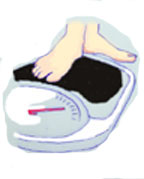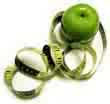Weight loss is no Secret!
Weight loss is no secret - eat fewer calories and exercise more
to burn more calories. Replacing your daily intake of low quality high
calorie processed carbohydrates with high fiber natural substitutes
will reduce your daily calories and skyrocket your health.
High Fiber Diets Work!
The greatest thing about fiber is that it can be eaten - and we all love to eat! A high fiber-rich meal is processed more slowly, which makes us feel satisfied sooner. Guess what? You eat less and lose weight. Match that with your trendy weight loss programs and all of those undesirable restrictions.
Fiber
doesn't have any calories, but because of its ability to absorb water,
that "full" feeling slows down your food intake. An apple is more
filling than apple juice. People with high fiber diets not only lose
weight, but are more likely to eat less red meat, drink less alcohol,
smoke less and commit to a fitness program. All of these healthy
behaviors can reduce the risk of cancer.
Diet is a major factor in 5 of the 10 leading causes of death. According to the U.S. Surgeon General's Call to Action to Prevent and Decrease Overweight and Obesity, released in 2001, approximately 300,000 adult deaths in the United States each year can be attributed to unhealthy dietary habits and physical inactivity or sedentary behavior.
According to the National Institute of Diabetes and Digestive and Kidney Diseases, just 33.5 percent of American adults are at a healthy weight.
Between
1960 and 2000, the total number of existing cases of overweight adults
increased from 31.5 to 33.6 percent in Americans between the ages of 20
and 74. During this same time period, the prevalence of obesity more
than doubled from 13.3 to 30.9 percent, with most of this increase
occurring in the past 20 years.
you need to know . . .
Fads, unbalanced diets, diet pills and supplements, weight loss surgery and other short term weight loss methods are not recommended for permanent weight control.
Your body weight is controlled by the number of calories you eat and the number of calories you use each day. To lose weight you need to take in fewer calories than you use. The best way to lose excess fat and maintain a healthy weight in the long term is to follow a balanced diet and do regular aerobic exercise.
|
|
Weight loss programs

Diets should encourage healthy behaviors that help you lose weight and that you can maintain over time.
Safe and effective weight-loss programs should include:
- Healthy eating plans that reduce calories but do not rule out specific foods or food groups
- Regular physical activity and/or exercise instruction
- Tips on healthy behavior changes that also consider your cultural needs
- Slow and steady weight loss of about ¾ to 2 pounds per week and not more than 3 pounds per week (weight loss may be faster at the start of a program)
- Medical care if you are planning to lose weight by following a special formula diet, such as a very-low-calorie diet
- A plan to keep the weight off after you have lost it
The Glycemic Index
A current system for classifying carbohydrates calls into question many of the old assumptions about how carbohydrates affect health. This ranking system, known as the glycemic index (GI), measures how fast and how far blood sugar rises after you eat a food that contains carbohydrates.
White bread, for example, is digested almost immediately to glucose, causing blood sugar to spike rapidly. So white bread is classified as having a high glycemic index. Brown rice, in contrast, is digested more slowly, causing a lower and more gentle change in blood sugar. It has a lower glycemic index.
Whenever possible, replace highly processed grains, cereals, and sugars with minimally processed whole-grain products.
Carbohydrates and the glycemic index
|
High-Glycemic
Potatoes |
Low Glycemic
Most legumes
|
Lose weight with fiber?
About half the calories eaten in this country are from refined foods, from which the bran, germ, and oil have been removed. The average intake of fiber is only 11 grams per day, compared to the daily recommended intake of 25 to 35gm.
Fiber by itself has no calories. Insoluble fiber adds bulk to the diet. Examples of insoluble fiber are whole grain breads and cereals and vegetables.

Soluble fiber helps your stomach feel full and leaves the stomach more slowly. Foods like seeds, fruits, and nuts are considered soluble. Foods with fiber take longer to chew and eat, so you feel full sooner and eat less. Eating between meals is lessened.
Fiber is not the cure all for weight control. However, it can help you lose weight. When adding fiber slowly to your diet, you can avoid bloating and gas. Fibrous foods draw water from the intestines.
Variety from both insoluble and soluble foods will provide benefits. Instead of drinking a glass of apple juice, eat the apple.
Click on the links to our high fiber recipes and high fiber menus for some more great ideas about how to lose weight with replacing your junk carbs with the healthy high fiber variety.
